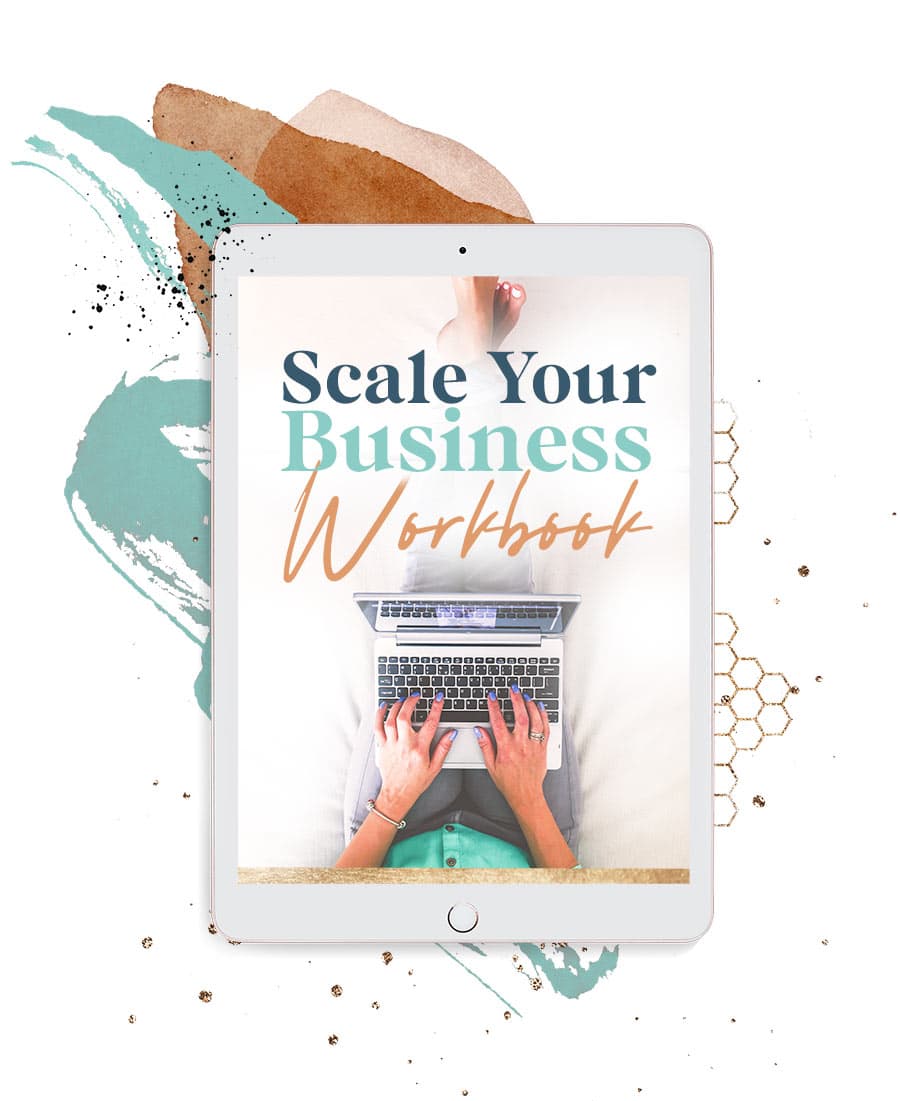On a mission to scale your service-based business – or get out of the “client work” grind forever?
(If you’ve ever secretly felt sick when a potential client DM’ed you – because you didn’t wanna take on the extra work – keep reading, my friend!)
Listen, as someone who’s been there, felt that, I intimately get how draining one-on-one work can be – especially when it’s your sole source of income. I mean, if you don’t “do the work,” you don’t get paid. But what if you’re sick, having a rough month mental-health wise or just in a super busy season when it comes to family stuff?
All of the above ^^^ is one of the big reasons I love offering a wide range of digital products.
Not only can you impact & serve a larger audience with your offers, you’ll also likely stack more cash and create a more stable monthly income. Oh, and you’ll also free up your time for what you truly desire–whether that’s free time to indulge in A Court of Thorn & Roses or feel less stressed when the kids’ “Spirit Week” rolls around (because who has time for client calls when you have super fun ‘fits to curate, right?).
Here’s the deal: If you’re reading this, you already know more than enough to start offering digital products right now. But what you might not know is how to take the courageous baby steps necessary to transform your “digital product empire” dreams into reality.
Well, I’ve got your back. Below, I’m revealing seven actionable steps that’ll help you create digital products your people actually want, so you can kiss “client work” life goodbye.
Step 1: Get Your ‘Client Biz’ Together
Before starting the journey from client work to digital product master, do your future self a major favor and get your existing client biz in order. Even if you don’t plan to take on new clients in the foreseeable future, you’ll want to make sure your current clients are taken care of (and still receiving a stellar customer experience). Not to mention, getting all your client shizz in order will also free up as much of your time as possible–time you can use to create and market your new digital offers!
This might look like:
– Automating as much as humanly possible
– Outsourcing or hiring a new team member (which you’ll definitely need to do as you dive deeper into product creation anyway)
– Delegating what you can to a VA or other specialized contractor already on your dream team roster
– Eliminating certain tasks altogether
Or any combination of the above.
Bottom line: You need your client biz running as efficiently as possible. So, before you even write a lick of content in a Google Doc for your upcoming (super profitable) digital product, comb through your current biz & see what needs a revamp, or what you can let go of altogether.
Step 2: Focus on Building a Digital Product Audience
Digital product-based businesses are–at heart–a numbers game. So, if you’re dealing with a teeny-tiny audience right now, it’s in your best interest to start spreading your message far & wide as soon as possible. (And now that you’ve streamlined the client side of your biz, you should have a few extra pockets of time to mark more consistently on social media, reach out to your fave podcast hosts, pitch guest posts, etc.)
That said, don’t overlook the people in your current audience. If you have clients (and any social media presence) right now, you already have an audience. Don’t dismiss them or automatically think they won’t be interested in your digital offers. Instead, do them a solid & let ‘em know about your shift. You can even offer them early access, exclusive promotions or ask them to be BETA testers to provide you with feedback or testimonials.
Step 3: Transform Your Service into a Scalable Digital Product
You’re probably exploding with digital product ideas and while you definitely can create one from scratch, focusing on turning your (already proven-to-sell) service into a scalable product is usually the path of least resistance for most entrepreneurs (precisely because you’ve sold the concept before, and already know all steps involved). Also, people already in your audience who maybe wanted to hire you for a while but didn’t have the cashflow will excitedly jump at the chance to buy your DIY product.
Here’s what that could look like: If you’re a graphic designer focused on creating brand kits for other entrepreneurs, maybe your first digital product is a “Create Your Own Brand Kit” mini (or not-so-mini!) course. You’ll simply transform your current methodology into a do-it-yourself product with customizable Canva templates and a few videos that walk your buyers through how to choose their own brand fonts, colors and create an easy logo.
Another option? Sell your past webinars, challenges and/or other pre-created content as stand-alone digital products (or bundles, too!). For example, if you ran a free 5-day challenge back in 2019 that’s no longer available, you could offer it as a low-cost digital product. This way, new people can access it – and even people who participated the first time can get lifetime access.
Either way, make it easy on yourself at first.
Step 4: Pre-Sell Your Products to Ease Risk
It’s important to validate any digital product idea you have before you pour all your biz savings and/or precious free time into it–and that’s where pre-selling comes in. If you do want to create a brand new product or dip into a new niche, you can market your digital product – and start collecting money for it – well before you create it. This will help you see (very clearly) whether it’s an offer people actually want. And sure, if nobody bites, you’ll need to head back to the proverbial drawing board and take a look at your marketing or messaging, price, etc. But you won’t be out anything, save for a little bit of time.
Step 5: Tweak Your Messaging and Marketing Strategies
Because digital products are generally lower in price than client work, you’ll need more people to buy them in order to match your private client income. Which means? You’ll need to market the heck out of your products–and you might have to change up your current client attraction strategies.
Since your “digital product audience” might be different than your private client audience, don’t be afraid to experiment with both your messaging (how you’re speaking to your peeps) and your marketing channels (where you’re speaking to your peeps). For example, DIY-loving Pinterest users might be more open to your digital products than TikTok viewers, at least in your particular niche. Pull out all the stops to see where you get the most traction–email marketing, social media, collaborations with influencers, you name it. And don’t forget how motivated humans are by a little urgency. Consider special launch discounts or exclusive bundles for early adopters.
Step 6: Diversify Your Digital Product Range
As time goes on, your digital product audience will grow and you’ll start to get to know the problems they’re willing to shell out coin to solve–which means you can start to create more products to solve ‘em!
Whenever you encounter a problem you could solve with a digital product, do future you a favor & jot it down. Then, go through the pre-sell process and/or create and launch it without a pre-sale (it really is up to you and your comfort level). Over time, you’ll be able to create an incredible library of products that cater to the various (but related, and in your zone of genius) needs of your customers. Consider opting for different “tiers” of products, too–you can offer anything from uber-affordable templates to comprehensive masterclasses or robust courses. You’ll not only diversify your income this way, you’ll also be able to cater to a wider audience with varying budgets and issues.
Step 7: Slowly Give Up the Client Work
There are no hard-and-fast rules about when you should completely give up client work. That said, I suggest making the move when your digital product revenue matches (or exceeds) revenue from your client work. Depending on how risk-averse you are, you might want to see a specific amount of revenue from digital products over a period of time to feel secure letting go of some client work. For example, maybe you need to make at least $2k per month from digital product sales for three (or six, or nine) months consecutively before you feel comfortable phasing out client work completely. Or maybe one $5k month is enough to say sayonara to ever having to do another sales call again.
You can transition as slowly–or quickly–as you want. And it’s easy to start: Just say yes to one less client a month than normal to see how it feels in both your nervous system and your bank account before saying less to two additional client the next month, etc.
The good news is, you can always take on private clients again if needed. There are no rules–just what feels right for you & the current season you’re in. Maybe you’ll pivot away from client work forever, or maybe you’ll work with just a select few every year. It’s truly your call.
And that’s it! Hope you enjoyed this mini-guide and it helps you create a thriving digital product business. It’s time to say yes to your own dreams, desires and biz growth, gorgeous!







